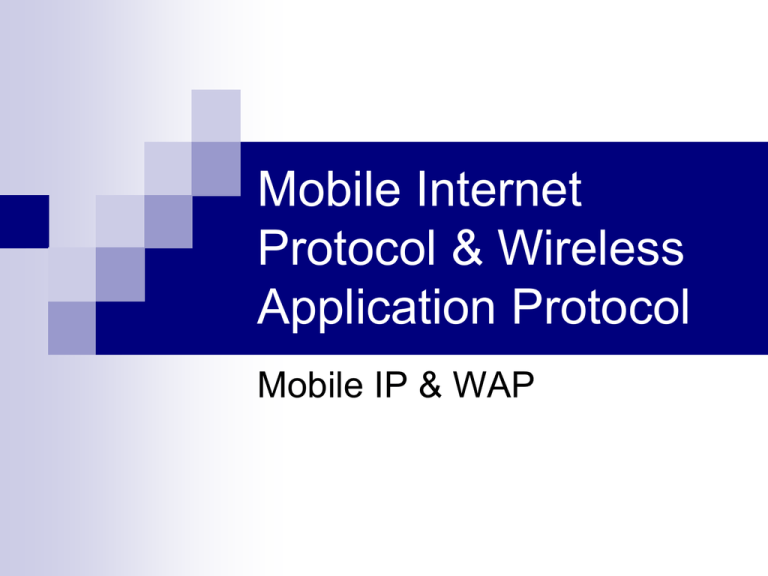Lecture Slides
advertisement

Mobile Internet Protocol & Wireless Application Protocol Mobile IP & WAP Class Index Mobile IP TCP/IP protocol architecture Operation of Mobile IP Discovery Registration Tunnelling Class Index Wireless Application Protocol Architectural Overview Wireless Mark-up Language WMLScript Wireless Application Environment Wireless Session Protocol Wireless Transaction Protocol Wireless Transport Layer Security. Wireless Datagram Protocol. Wireless Control Message Protocol. Introduction Mobile IP & WAP are standards that provide APPLICATION LEVEL support for wireless networking Mobile IP refers to maintenance of Internet connectivity while moving from one attachment point to another. TCP/IP Protocol Architecture Data exchange between computer terminals and/or other data processing devices can be quite complex There must be a data path between the two computers: There must be a high degree of cooperation between the two computer systems TCP/IP Protocol Architecture The task of implementing the communications infrastructure is broken up in subtasks, each of which is implemented separately In a protocol architecture the modules are arranged in a vertical stack Each layer in the stack performs a related subset of the functions required to communicate with another system TCP/IP Protocol Architecture Each layer relays on the next lower layer to perform more primitive functions and to conceal the details of those functions Each layer provides services to the next higher layer. Ideally changes in one layer should not affect other layers. TCP/IP Protocol Architecture Communications Involve 3 Agents: Applications Computers Networks Communications Tasks are organized into 5 relatively independent layers TCP/IP The physical layer covers the physical interface between a data transmission device and a transmission medium or network. The network access layer is concerned with the exchange of data between an end system (server, workstation) and the network to which it is attached TCP/IP The Internet layer deals with procedures to allow data to transverse multiple interconnected networks. The Internet Protocol (IP) is used in this layer to provide routing functions across multiple networks. TCP/IP IP is implemented in end systems and routers A router is a processor that connects two networks and whose primary function is to relay data from one network to the other TCP/IP The Transport layer deals with the mechanisms that provide reliability independently of the nature of the applications. The Transmission Control Protocol (TCP) is the most commonly used protocol to provide this functionality TCP/IP The application layer contains the logic needed to support the various user applications. Mobile IP In the networking context, mobile implies the following: A user is connected to one or more applications across the Internet. The user’s point of attachment changes dynamically All connections are automatically maintained despite the change Operation of Mobile IP Routers are used to move IP datagrams through the network using IP addresses that are fixed and controlled by TCP connection that knows the IP addresses of the communicating computers Mobile IP deals with the problem that arises when the IP address changes while the TCP connection is active Definitions Home Network: Network where the mobile node belongs originally Home Address: IP address of the mobile node in the home network (static) Foreign Network: Network different from the home where the mobile node is connected at the moment. Definitions Foreign Agent: Typically a router on the foreign network. It controls traffic in that network. Home Agent: Typically a router on the home network that controls traffic in that network Care-of Address: Temporary IP address assigned to the mobile unit by the foreign network Network Level PDU Operation of Mobile IP Encapsulation and Tunnelling IP datagram to A A’s response travels directly to X due to fixed IP of X IP Mobile Basic Capabilities Discovery: A mobile unit uses a discovery procedure to identify prospective home agents and foreign agents. Registration: A mobile node uses an authenticated registration procedure to inform its home agent of its care-of address Tunnelling: Tunnelling is used to forward IP datagrams from a home address to a care-of address. Discovery Need to determine if the node is in its home network or on a foreign network. This is done through Advertisement. A transmission from the home network to a foreign network can occur at any time without notification to the network layer (IP layer) discovery for a mobile node is a continuous process. Discovery – Move Detection Mobile nodes may move between networks due to some handoff mechanism without the IP level being aware of it. Agent Discovery Process is intended to enable the agent to detect such move. There are two algorithms used for this: Use of Lifetime Field Use of Network Prefix Move Detection Algorithms Lifetime Filed: When a mobile node(MN) receives an agent advertisement from a foreign agent that it is currently using or that it is now going to register with, it records the lifetime field as a timer If the timer expires before the MN receives another agent advertisement from the agent, then the node assumes that it lost contact with that agent. If the MN has received an agent advertisement from another agent, and that advertisement has not yet expired, the MN can register with this new agent. Move Detection Algorithms Network Prefix: The mobile node (MN) checks whether any newly received agent advertisement is on the same network as the node’s current care-of-address. If it is not, the MN assumes that it has moved and may register with the agent whose advertisement the mobile node has just received. Registration Once a mobile node has recognized that it is on a foreign network and has acquired a care-of address, it needs to alert a home agent on its home network and request that the home agent forward its IP traffic Registration The registration process involves four steps: 1. 2. 3. 4. The mobile node requests the forwarding service by sending a registration request to the foreign agent that the mobile node wants to use. The foreign agent relays this request to the mobile node’s home agent. The home agent either accepts or denies the request and sends a registration reply to the foreign agent. The foreign agent relays this reply to the mobile node Tunnelling Once a mobile node is registered with a home agent, the home agent must be able to intercept IP datagrams sent to the mobile node’s home address so that these datagrams can be forwarded via tunnelling To forward an IP datagram to a care-of-address, the home agent puts the entire IP datagram into an outer IP datagram. This is a form of encapsulation Tunnelling Three options for encapsulation are allowed for Mobile IP: IP-within-IP encapsulation: IP datagram is inserted into a new IP datagram with the care-of address. Minimal Encapsulation: Less overhead, only a few fields are added in the outer datagram. Generic routing encapsulation (GRE): This is a generic encapsulation procedure that was developed prior to the development of Mobile IP Wireless Application Protocol Is a universal, open standard developed to provide mobile users of wireless phones and other wireless terminals access to telephony and information systems, including the Internet and the Web. WAP is designed to work with all wireless network technologies WAP is based on existing Internet standards Mobile Devices Limitations for Data Services limited processors, memory and battery life. The user interface is limited and the display is small. The wireless networks are characterized by relatively low bandwidth, high latency, and unpredictable availability and stability compared to wired connections WAP specifications A programming model based on the WWW programming model. A Markup language, the Wireless Markup Language (WML), adhering to XML A specification of a small browser suitable for a mobile, wireless terminal A lightweight communication protocol stack. A framework for wireless telephony applications (WTAs). WAP Specifications: Protocols & Modules WAP Architecture The WAP programming Model is based on three elements: the client. the gateway. the original server. Common Gateway Interface The WAP environment WAP Architecture The WAP architecture is designed to cope with the two principal limitations of wireless Web access: the limitations of the mobile node (small screen size, limited input capability) and the low data rates of wireless digital networks. WAP Architecture Even with the introduction of 3G wireless networks, which will provide broadband data rates, the small hand-held mobile nodes will continue to have limited input and display capabilities. WAP or a similar capability will be needed for the indefinite future. Wireless Markup Language (WML) designed to describe content and format for presenting data on devices with limited bandwidth, limited screen size, and limited user input capability. It is designed to work with telephone keypads, styluses, and other input devices common to mobile, wireless communications. WML permits the scaling of displays for use on two-line screens found in some small devices, as well as the larger screens found on smart phones WML Features Text and image support: Formatting and layout commands are provided for text and limited image capability. WML Features Deck/card organizational metaphor: WML documents are subdivided into small, welldefined units of user interaction called cards. Users navigate by moving back and forth between cards. A WML deck is similar to an HTML page in that it is identified by a Web address (URL) and is the unit of content transmission. Supprot for navigation among cards and decks: Includes provisions for event handling, which is used for navigation or executing scripts WMLScript Scripting language with similarities to JavaScript. Designed for defining script-type programs in a user device with limited processing power and memory. Wireless Application Environment (WAE) specifies an application framework for wireless devices such as mobile telephones, pagers and PDAs. Consists of tools and formats that are intended to ease the task of developing applications and devices supported by WAP Wireless Session Protocol (WSP) WSP is a transaction-oriented protocol based on the concept of a request and a reply. Each WSP protocol data unit (PDU) consists of a body and a header. WSP also defines a server Push operation, in which the server sends unrequested content to a client device. Wireless Session Protocol (WSP) WSP provides applications with an interface for two session services. The connection-oriented session service operates above the reliable transport protocol WTP, (transaction protocol) The connectionless session service operates above the unreliable transport protocol WDP. (datagram protocol) Wireless Session Protocol (WSP) WSP is based on HTTP with some additions and modifications to optimize its use over wireless channels. The principal limitations addressed are low data rate and susceptibility to loss of connection due to poor coverage or cell overloading. Wireless Transaction Protocol (WTP) WTP manages transactions by conveying requests and responses between a user agent (such as a WAP browser) and an application server for such activities as browsing and e-commerce transactions. WTP provides a reliable transport service but dispenses with much of the overhead of TCP, resulting in a lightweight protocol that is suitable for implementation in “thin” clients (e.g. mobile nodes) and suitable for user over low-bandwidth wireless links. Wireless Transaction Protocol (WTP) - Features Three classes of transaction service. Optional user to user reliability: WTP user triggers the confirmation of each received message Optional out-of-band data on acknowledgments. PDU concatenation and delayed acknowledgment to reduce the number of messages sent. Asynchronous transactions Wireless Transport Layer Security (WTLS) WTLS provides security services between the mobile device (client) and the WAP gateway. Used along with TLS (Transport Layer Security) to provide end-to-end security WAP systems translate between WTLS and TLS within the WAP gateway Wireless Transport Layer Security (WTLS) - Features Data Integrity: Ensures that data sent between the client and the gateway are not modified, using message authentication. Privacy: Ensures that the data cannot be read by a third party, using encryption. Authentication: Establishes the authentication of the two parties, using digital certificates. Denial-of-service protection: Detects and rejects messages that are replayed or not successfully verified. Wireless Datagram Protocol WDP is used to adapt a higher-layer WAP protocol to the communication mechanism (called the bearer) used between the mobile node and the WAP gateway. WDP hides details of the various bearer networks from the other layers of WAP Wireless Control Message Protocol (WCMP) WCMP is used by wireless nodes and WAP gateways to report errors encountered in processing WDP datagrams. WCMP can also be used for informational and diagnostic purposes.








